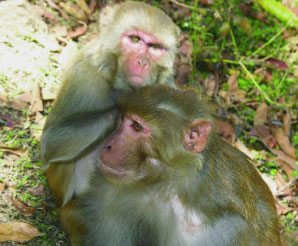Contents
News from NCRR
Genome of the Rhesus Macaque Unveiled
Scientists had already laid bare the complete genetic codes of humans and chimpanzees. They have now added a third primate to the list of sequenced genomes: the rhesus macaque or, by its Latin name, Macaca mulatta. This old-world monkey is the nonhuman primate most widely used in biomedical studies focusing on major diseases, such as AIDS and diabetes. Its genome sequence is reported in the April 13, 2007, issue of Science magazine.

The effort to sequence the rhesus macaque genome was supported by several NCRR-funded National Primate Research Centers. (Photo by Randall C. Kyes / University of Washington)
The sequencing, funded by NIH’s National Human Genome Research Institute, was performed at the Baylor College of Medicine Human Genome Sequencing Center in Houston, Texas; the Genome Sequencing Center at Washington University in St. Louis, Missouri; and the J. Craig Venter Institute in Rockville, Maryland.
It was based on the DNA from a single individual—a female rhesus macaque housed at the NCRR-funded National Primate Research Center (NPRC) at the Southwest Foundation for Biomedical Research in San Antonio, Texas. The California, Oregon, and Yerkes NPRCs, also funded by NCRR, contributed additional biological samples used in the study.
The human genome was sequenced in 2001. With the sequencing of the chimpanzee (Pan troglodytes) genome in 2005, scientists were able to investigate which genes humans share with this close relative, from which they diverged about 6 million years ago. Macaques are more distant in the evolutionary timescale, as they are believed to have diverged from humans 25 million years ago.
But this distance is actually useful for studying evolution. By comparing rhesus macaque and human DNA, which are about 7 percent different from one another, scientists can see which genes have been conserved in primates over time and which ones have not. Compared to the human genome, the chimp genome is only about 1.5 percent different.
The Science article describes about 200 genes that probably play a key part in determining differences among primate species, including genes involved in hair formation, immune response, membrane-protein generation, and sperm-egg fusion. Also, researchers found some intriguing examples where a normal form of a macaque gene looks like a diseased human gene.



